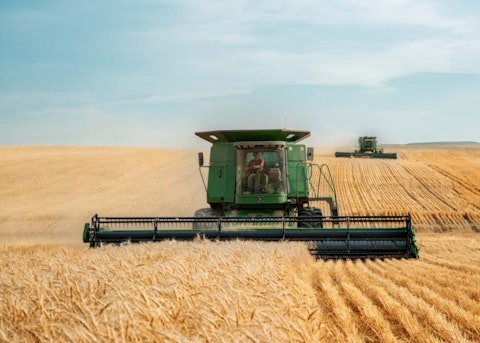In this article, we will be taking a look at the 20 biggest American food exports in recent years. To skip our detailed analysis, you can go directly to see the 5 biggest American food exports by year.
The food industry in the U.S. is an absolute giant, and it is one of the top food exporting countries in the world, being the global leader in the export of various types of food. In 2021, U.S. agricultural trade reached record levels and exports alone were valued at $177 billion, while this increased further by 11% in 2022 to reached $196 billion, with high value products accounting for nearly 75% of total food exports. While the U.S. may be an industrial nation and the most advanced country in the world, these aforementioned statistics show that its agricultural output is significant too, and it’s advancements in technology that have led to increased agricultural output.
Tech advancements in the food industry
While tech advancements have led to massive growth in industrial nations, such advancements have been successfully applied to the more traditional agricultural sector to improve yield and efficiency, while significantly lowering costs. While such technologies have been implemented in the agricultural industry since the 20th century, exponential development has led to tech becoming much more associated with farming and agriculture in the 21st century and especially in the last two decades, and companies such as Bayer, one of the biggest pharmaceutical companies in the world, are embracing this wholeheartedly, with Bayer creating a division called Bayer Crop Sciences to merge science and agriculture. Bayer Crop Sciences provides several such innovative solutions including using innovative digital tools and data science where farmers are able to use data aggregated through third parties and satellites while also incorporating machine learning techniques. Additional tech advancements come in the form of using remote sensors which have the ability to diagnose yield-impacting field issues, while the usage of unmanned aerial vehicles, or drones, is also gaining in popularity, though not in countries where drones are banned.

Photo by Darla Hueske on Unsplash
While Bayer Crop Sciences isn’t the only company which merges farming and technology, it is considered to be a market leader and Bayer Crop Sciences recorded an exceptionally strong year with sales increasing by 15.6% to over 25 billion euros, and expect a further 3% growth in its Crop Sciences division. The division also launched new products which aim to not just improve harvest effectively, but also considerably reduce environmental impact. This was called out by the company in its Q2 2023 earnings call stating ” In June, our market leading Crop Science business articulated a vision for regenerative agriculture that’s good for on-farm productivity. It’s good for farmer incomes and it’s good for the earth. And the faster we can translate this into revenue growth, the better for all. It’s great to see the first registrations coming in for our Preceon Smart Corn System, a climate resilient version of one of the most important crops for agriculture and for Bayer.” The company mentioned further additional technologies in the same call, mentioning “I would highlight the continued upgrade of our most significant segment, our industry leading Corn Seed & Traits business as an example. Growers across the Americas continue to demand more of our third generation corn rootworm control trait with RNAi technology, building on an important insect control offering in our portfolio. Even more exciting are the ongoing farm trials around the globe for the Preceon Smart Corn System, featuring our short stature corn. This product has the potential to change how farmers grow corn and for the better with less yield loss to the high winds, more optimized fertilizer and crop protection use, better field access and season long and opportunity for higher planting densities, we see a potential fit on 220 million acres around the globe and more than EUR1.5 billion in peak sales potential.” These technologies have also been major contributors to the most exported American food exports by year.
GMOs and their future
GMOs, or genetically modified organisms, gained in popularity from Monsanto, which was one of the biggest food companies in the world before its purchase by Bayer in 2016, in a deal worth $66 billion. While GMOs still attract significant controversy, they are hugely beneficial in terms of yield and are the reasons why U.S. has some of the highest food exports in the world. A study conducted in this respect concluded that using GM technology resulted in crop yields increasing by a stunning 21%, not because of higher genetic yield potential but due to better pest control and hence, less crop damage and wastage. Since GM crops are already better at pest control, this also results in less usage of pesticides which further decreases costs. While GM seeds are more expensive than normal ones, the savings in pesticides meant that farmers using GM seeds actually had higher profits by 69%, and the biggest American food exports are continuing to see a rise in production and export numbers precisely because of technology like this.
Genetically modified foods also have another large benefit for the future; they are much more resistant to climate change than ordinary crops. As the impact of climate change continues to be felt year on year, many crops including staples such as potatoes, maize and wheat not to mention wealthier crops including coffee and cocoa have seen yields decline in the countries most impacted by climate change, and the usage of genetically modified crops may help alleviate some of this crisis.
Outlook of the U.S. food industry
The growth exhibited by the U.S. food industry is expected to growth an incredible CAGR of over 10% from 2022 to 2030, and is likely to cross $1.7 trillion in total market size, which allows for a lot of potential in terms of growth for some of the biggest food companies in the U.S., including Archer-Daniels-Midland Company (NYSE:ADM), which mentioned how its continuing to increase output in its Q2 2023 earnings call, stating “Our Spiritwood, North Dakota processing facilities is scheduled to start up in Q4, adding 1.5 million metric tons of annual soy crush capacity to our portfolio and producing low carbon intensity soybean oil for our JV partner Marathon’s nearby renewable diesel facility. Projects like this will support growing demand for renewable diesel and sustainable aviation fuel throughout the industry. We also see continued resilience in food demand for core products. We expect the continued solid margin and volume environment for sweeteners, starches and flavors. We are beginning to convert our pipeline of wins in Human Nutrition into operating profit. Where there are some factors that have hindered growth in the portfolio, we believe positive momentum from Flavors is a predictor of a healthy rebound.” Archer-Daniels-Midland Company (NYSE:ADM) also went on to discuss the impact of technology and food production in the call, stating “Our new Decatur protein solution center is engaged in ADM’s world-class science and technology capabilities to deliver on tomorrow’s most important consumer nutrition trends. Collaboration between ADM and our ventures partners take us beyond today’s alternative protein sources to help address critical areas of sustainability, wellness and affordability. Leveraging our deep fermentation expertise and capacity is positioning us to scale the next generation of food, feed, fuel, fabrics and other industrial products with key partners. The combination of technology alongside global trends in sustainability, food security and well-being is transforming the food and agriculture industry at the fastest pace since the last century. And ADM is at the forefront of this transformation and connected growth opportunities, which give us even more confidence in our long-range growth plans.”
Methodology
To determine the biggest American food exports by year, we headed over to the United States Department of Agriculture, which has statistics on each type of food exported by year and its total value. We checked the total exports, by dollar value, of each type of food from 2021 to 2023 YTD and ranked them based on highest dollar value exports to lowest.
20. Wine
Total exports from 2021 – July 2023 YTD (in millions): $3,817
U.S. wine exports remained unchanged from 2021 to 2022, and in 2023, have declined 20% as compared to the same period in 2022, though it’s still among the largest wine exporters in the world.
19. Fruits, prepared or preserved
Total exports from 2021 – July 2023 YTD (in millions): $4,717
Preserved fruit exports from the U.S. haven’t seen the same increase in demand as fresh fruits, though the U.S. is still one of the biggest exports of dried fruits in the world.
18. Sugar and tropical products
Total exports from 2021 – July 2023 YTD (in millions): $4,767
Sugar and tropical products exports have declined by 5% in 2023 when compared to the same period for 2022.
17. Rice
Total exports from 2021 – July 2023 YTD (in millions): $5,128
U.S. rice exports declined 12% from 2021 to 2022, while India is the biggest rice exporter in the world, and its recent ban on non-basmati rice exports have raised concerns of rice prices increasing across the world.
16. Other oilseeds
Total exports from 2021 – July 2023 YTD (in millions): $5,501
Other oilseed exports were one of the only most exported American foods to see a decline from 2021 to 2022.
15. Distilled spirits
Total exports from 2021 – July 2023 YTD (in millions): $5,741
Distilled spirits are continuing to consolidate their position among the most exported U.S. foods in 2023, and have already exceed in July 2023, their total export sales in 2022, which itself registered a 30% increase against 2021.
14. Vegetables, fresh
Total exports from 2021 – July 2023 YTD (in millions): $7,917
Canada is the biggest recipient of fresh vegetables from the U.S., which registered a 4% growth from 2021 to 2022.
13. Ethanol (non-beverage)
Total exports from 2021 – July 2023 YTD (in millions): $9,484
After cotton, ethanol registered the highest increase from 2021 to 2022, with exports increasing by $1 billion from $2.8 billion in 2021 to $3.8 billion in 2022. 2023 has continued the strong growth, and by July, almost $3 billion worth of ethanol exports had already been made by the U.S.
12. Vegetable oils
Total exports from 2021 – July 2023 YTD (in millions): $10,728
U.S. vegetable oil exports do not include soybeans, and Canada, Singapore and Mexico are the biggest recipient of U.S. vegetable oil exports.
11. Fruits, fresh
Total exports from 2021 – July 2023 YTD (in millions): $11,793
While the U.S. is a major importer of fruits, including many of the most consumed fruits in the country, it is also a major exporter with apples, grapes and pears being the the biggest fruit exports, contributing to fresh fruits being among the most exported American foods in 2023.
10. Vegetables, prepared or preserved
Total exports from 2021 – July 2023 YTD (in millions): $13,731
While prepared or preserved vegetables exports from the U.S. barely changed from 2021 to 2022, 2023 has seen strong growth, and has already nearly reached FY 2022 figures.
9. Poultry meats and products
Total exports from 2021 – July 2023 YTD (in millions): $18,082
Colombia is one of the biggest markets for U.S. poultry, and recently saw a temporary ban on poultry exports to the country by the U.S. lifted in July 2023.
8. Cotton and linters
Total exports from 2021 – July 2023 YTD (in millions): $20,665
Three-fourth of the cotton produced by the U.S. is exported, and it’s the biggest cotton exporter in the world, though Brazil is threatening this position as Texas, the largest cotton producing region in the U.S., has seen production drop significantly because of changing weather patterns.
7. Wheat
Total exports from 2021 – July 2023 YTD (in millions): $21,129
The U.S. used to be a world leader in wheat exports but lost that position around a decade ago. Wheat prices for the U.S. and beyond reached record levels in 2022 but have slowed down since.
6. Dairy products
Total exports from 2021 – July 2023 YTD (in millions): $24,401
U.S. dairy products exports jumped by 25% in 2022 and if the current run rate continues, will register another 30% growth in 2023, firmly cementing its place among the most exported U.S. food products.
Click to continue reading and see the 5 Biggest American Food Exports by Year.
Suggested Articles:
- 25 Biggest Web3 Companies In The World
- 10 Best Silver ETFs
- 10 Biggest EV Charging Companies in the US
Disclosure: None. 20 biggest American food exports by year is originally published on Insider Monkey.





